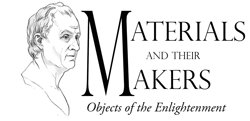Sèvres Porcelain Palette
The Enlightenment invented colors according to its new values. Breakthroughs in chemistry and optics, notably by Isaac Newton and René Descartes, introduced a scientific attitude to the creation of color. The use of these technological colors in luxury goods initiated the spread of their experience to everyday consumers. Nowhere was this phenomenon more pronounced than in the medium of porcelain. Like all Europeans, the French were obliged to re-invent the technology of porcelain in order to compete with imports from China. In the process, the Sèvres porcelain factory created many of the bright, intense shades most visually characteristic of the period.
When trading with Asia began in the second half of the seventeenth-century in France and in Europe, porcelain immediately gained attention for its rarity and beauty.[i] As a result monarchs, aristocrats, and members of the court sought to purchase Asian porcelain wares to adorn their mantels, tables, and boudoirs. As imported porcelain continued to proliferate, its status as ‘la plus belle objets en vogue’ reached new heights and it became a necessity of intellectualism, wealth, and style to own, display and dine off of porcelain in one’s home. The more popular the act of collecting Asian porcelain became, the higher the demand got for companies like the French East India company to amass a greater supply of the luxury material.[ii] Consequently, national economies suffered around Europe and, beginning in 1700, finance ministers set in motion the process of encouraging artisans, chemists, and investors to set up porcelain manufactories on home soil.[iii]
The Meissen factory in Saxony was the first European porcelain manufactory to produce on a commercial scale beginning in 1710 and sold porcelain wares at a level which rivaled the sales of Asian porcelain on the consumer market. The bodies they created had traces of East Asian style but were ultimately conceived in a fashion that was inherently new. Particularly, Meissen gained fame for its group biscuit figurines[iv] that could be bought to adorn dining tables during the dessert course of a formal meal. Uniquely, the Meissen factory was under the patronage of Augustus the Strong, King of Poland, and thus with unlimited financial backing, the factory soon created both shapes and glaze colors that truly rivaled East Asian porcelain on the market in Europe. Meissen set a precedent, which was fundamental to Sèvres by having a royal patron. Court investment is in fact essential to the success, innovation, and ultimate legacy of Sèvres porcelain and the point here is that inspiration for such a financial commitment could have very well derived from the precedent set by Augustus the Strong in Saxony with the Meissen factory.
The new medium of porcelain created an unprecedented opportunity for chemists and artisans to collaborate in an effort to transcend the mystery of porcelain production as well as, after the formula for the wares was perfected, to create colors to glaze the fired material. Why, might you ask, was this an unprecedented opportunity for chemists and artisan to collaborate? Because of the enlightenment and proliferation of public knowledge transcending field boundaries and guild system regulations. Soft-paste-porcelain (pâte tendre) is artificial porcelain invented in Europe to imitate hard-paste, or the true porcelain of the East. In order to develop porcelain, individuals had to undergo trial and error on a large scale. Furthermore, the ingredient required to produce true porcelain (that which was imported and highly regarded from China and Japan throughout the seventeenth and eighteenth centuries) was a pure aluminum silicate known as kaolin. This is known now, but in the eighteenth-century chemists and inventors knew nothing about kaolin or where to find it. As such, soft-paste-porcelain sufficed in place of true hard-paste-porcelain; soft-paste is artificial and made with powdered glass as a substitute for the kaolin used in hard-paste porcelain. Other differences between soft and hard paste porcelain include heat resistance and translucency; soft-paste porcelain is fired at a lower temperature than true porcelain and is not as translucent as kaolin- based porcelain.
[i] Castelluccio, Collecting Chinese and Japanese Porcelain in Pre-Revolutionary Paris.
[ii] Castelluccio, Collecting Chinese and Japanese Porcelain in Pre-Revolutionary Paris.
[iii] Eriksen, Sèvres Porcelain. Forward.

